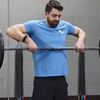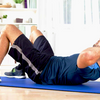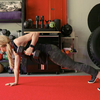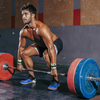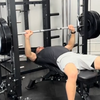Ultimate Guide to Chest-Supported Rows: Techniques and Equipment
What is a Chest-Supported Row?
The chest-supported row is primarily an upper-body exercise that works the middle and upper traps, rhomboids, and lats. It's a bit different from your standard row in the fact that you're able to support with the chest on an incline bench; therefore, it reduces the chance of a lower back strain, allowing you to keep good form on the lift.

Why Include the Chest-Supported Row?
Here are plenty of reasons why one would include chest-supported rows in their training program:
- Reduced Strain on Lower Back: One of the biggest boons of chest-supported rows is the reduced amount of strain on your lower back. With most traditional row exercises, lifters are forced to maintain some degree of a bent-over posture, which causes a lot of stress on the muscles around the lower back and sometimes even on the spinal column. Since you lie face-down on a bench, it's the chest that supports the upper body; therefore, the need to stabilize the lower back is absolutely done away with. This is especially great for someone with prior lower back issues or injury who is looking to strengthen their back muscles but without putting on undue stress.
- More muscle isolation: In that the rows are chest-supported, they aid in increasing muscle isolation in the upper and middle back—the very best muscles such as the rhomboids, trapezius, and latissimus dorsi. Your body is static in one position on the bench, giving you the ability to truly let your back be the workhorse in the pull, rather than balancing and supporting your body through your legs and core. This focused activation aids in muscle engagement and hence, possibly better muscle development and growth. The controlled environment also minimizes the risk of compensating with momentum or other muscle groups, which is common in standing rows.
- Versatility:Another great benefit of chest-supported rows is their versatility; they can be done with a great variety of equipment, from dumbbells and barbells to some specialized row machines. On top of this, adaptability is great for different fitness and strength levels; different grips and angles change the muscle target. Further, changing the equipment varies the exercise in terms of stimulation and challenge, helping progress the workout continuously.
Chest-supported rows can be part of an exercise regime that effectively and safely develops back strength and muscles, enhances isolation of muscles, and supports preferences for and needs of workouts.
Equipment You Will Need
Now, to get you started, you will need the following equipment, which is best for home and gym use:
1. Adjustable Weight Bench
An adjustable weight bench might be one of the biggest necessities for doing numerous strength training exercises. Exercises such as the bench press, dumbbell row, and seated shoulder press are mainly dependent on this flexible weight bench. An adjustable weight bench with incline/decline settings is preferred, and this is RitFit's Multi-Adjustable Heavy-Duty Incline Training Weight Bench:
- Sturdiness: It should have a solid weight bench, especially during exercises when you may be required to lift heavy weights. The engineering on the RitFit bench was with sturdy high-quality materials that can stand the toughest workout conditions.
- Adjustability: The angle of the incline of the bench can be altered, which means all sorts of exercises can be done that touch many muscle groups. From incline presses to decline flyes, the adjustable nature offers a position that is very appropriate, thereby creating an optimal muscle engagement.
- Comfort: Padding and upholstery of the bench both are some of the main contributors to comfort during exercises. This calls for the need for a bench that has quite enough padding and durable upholstery to support the body through the exercises, therefore one is not uncomfortable during long hours of workouts.

2. Dumbbells:
These are essential tools for strength work and versatile in giving a variety of exercises to reach many muscles. The RitKeep Rubber Hex Dumbbells have effectively combined user comfort and durability into one. This is why it is one of the best:
- Ergonomically Designed: Dumbbells are designed with ergonomically beneficial handles for grip comfort, thus minimizing the levels of stress one could be exposed to on their hands and wrists during training. The ergonomic design provides a more natural range of motion and control with the weights.
- Rubber Coating: The rubber coating of the dumbbells is rubber-coated from the outside, giving it a two-fold protective nature. It serves to protect the floor in the event that weights should fall and also dulls noise, which makes it possible to be used comfortably within the home.
- The versatility: Be it curling your biceps, pressing your shoulders, or simply doing lunges, a dumbbell offers limitless variations in the movements you can do with it. And the flexibility goes way up with adjustable dumbbells; you can change the resistance very quickly, often in the time it takes to do a set.

3. Barbells:
Barbells are versatile tools, making them ideal pieces of equipment in strength training, hence allowing lifters to place much weight. Any user can perform heavy workouts with the Ulti-Purpose Bearing Olympic Powerlifting Barbell, which was designed for commercial use and has a stable foundation for squats, deadlifts, and bench presses. Here's why it's a top choice:
- Safety and Performance: A great barbell will also guarantee overall safety and performance. The Ulti-Purpose Barbell is designed out of high-strength steel in combination with precision bearings to guarantee long-lasting performance under heavy loads.
- Bearing System: Smooth and fluid, the bearing system on the barbell reduces friction to a minimum, hence reducing strain on your joints. This smooth rotation enhances your lifting experience to focus on having good form and technique.
- Adaptability: The barbell is compatible with standard Olympic weight plates, and this enables unlimited ways in which the resistance could be either progressed or specifically tailored. Whether you're a complete beginner or an experienced lifter, it's easy to adjust the weight to your strength level and objectives.

By investing in quality equipment like the adjustable weight bench, dumbbells, and barbell, you can have all it takes to build your strength, muscle definition, and really get those goals to come to life in an effective and efficient manner.
Instructions for Chest-Supported Row
Step 1: Set Up
- Lean the bench at an angle of 45 degrees so that the chest is supported easily.
- Lie face down on the bench, so that the pads are on the chest and your feet are flat against the floor.
- Hold the dumbbells so that the palms face each other.
Step 2: Execution
- Start in a position where your arms are extended, and weights are in a line directly under your shoulders.
- Squeeze your back muscles and breathe out as you raise the dumbbells to a hip height. Make sure your elbows are tight against the side of the body as the dumbbells are raised.
- Bring the dumbbells around the height of your lower ribs, controlling the weights themselves.
- Squeeze your shoulder blades at the top of the movement. Really give them a good squeeze for a second to get that maximum contraction and muscle engagement.
- Now slowly and under control, breathe in and lower the dumbbells back to their starting position without letting the weight pull.
Step 3: Success Strategies
- Keep the neck in a relaxed position by not straining it, and the head should remain in line with the spine. Maintain a neutral neck position throughout the exercise.
- Emphasize the controlled movement and the absence of swinging the weights to avoid injury and activate the proper use of the muscles.
- Scale the weight to ability and level of fatigue. Most importantly, maintain good form above everything, especially when fatigued.
- If you are new to the exercise or having a bit of an issue with it, maybe you want to start off a bit lighter just to get the groove of the movement pattern down pat.
- Include this movement in your workouts; it is very useful for strengthening your back and improving your posture. Combine this exercise with others for the compound upper body workout.
Variations and Modifications
Bent-over Row: A good alternative to the typical dumbbell setup is the chest-supported row with a barbell. The recruitment will be quite different, so it makes it a great challenge for the muscles on your back.
- Set Up: Lay face down on the bench, your chest is against the pad, feet flat on the floor, and hold the barbell with an overhand grip; a little wider than shoulder width.
- Performance: Pull the barbell upwards towards your lower ribs with your elbows really well tucked. Consciously squeeze the shoulder blades together at the peak before lowering the barbell slowly back down towards the start.
Single-Arm Dumbbell Row: This variation allows you to focus on one side of your back at a time, helping you address muscle imbalances and develop better unilateral strength.
- Set Up: Lie face down on the bench with the chest pressed against the top of the pad and both feet flat on the floor. Grab a dumbbell in one hand with the hand placed so the palm is facing the body.
- Execution: Pull the dumbbell in the direction of your hip and ensure the elbow is pinned close to the body. Squeeze the shoulder blade at the top of the motion before lowering back to the initial position. Do it on the other side.
Reverse Grip Row: An underhand grip will primarily emphasize other muscles, particularly the lower lats and biceps.
- The setup and execution are virtually the same as with the regular chest-supported row, only your palms will face the ceiling.
- Lift the dumbbells up toward your hips, keeping your elbows close to your body. Try to squeeze your shoulder blades together at the top of the movement, and after that, lower the dumbbells back to the starting position.
These variations can also spice up your workout, target different muscles, and help overcome the plateau of your progress. Remember: maintain proper form and adjust the weight as needed to ensure safety and effectiveness.
Putting it Together
Chest-supported row is a very good exercise that helps in developing a strong and muscular back by being easy on the spine. Incorporating this row into your routine, whether you are a beginner or a seasoned athlete, will lead to great improvements in strength, posture, and overall back health. You are set for success with the right equipment and technique.
FAQs
1. How often should I perform chest-supported rows?
Incorporate this exercise 1-2 times per week, ensuring to rest of the back muscles are adequately between sessions.
2. Can beginners perform chest-supported rows?
Yes, this exercise is beginner-friendly due to its stability and reduced risk of improper form.
3. What are the common mistakes to avoid?
Avoid lifting too heavy, and too fast; prioritize form over ego to prevent injuries and maximize gains.
